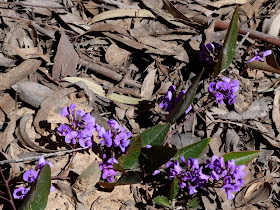The contribution of broken hearts to the advancement of
Australian botany has, I think, been underestimated. On the other hand very few
plants bear women's names; this is a story that combines the threads, though
not perhaps as you might suppose.
Carl
Alexander Anselm, the Baron von Huegel, was the son of the flourishingly named Concommissarius
of the Reichstag, who had to flee with his family to Austria at the turn of the 19thcentury, when young Carl was only five. Carl later fought in the Austrian cavalry against Napoleon, returning to civilian life and his passion for natural history in 1824, expressed in his magnificent Vienna garden which featured many of the then fashionable plants of New Holland. Things were about to turn sour for him however, though European appreciation and understanding of Australian plants would benefit. His beloved fiancée Melanie, apparently under extreme pressure, broke off her engagement to Carl in favour of his patron, the chancellor Prince
Metternich, to whom he nonetheless managed to remain loyal.
 |
| Hardenbergia violacea |
He couldn't bear to stay in the same city however, and in his words became “a
man who sought healing and oblivion in every land on earth”. Plants he collected throughout the new worlds poured back into Europe; these included the treasures gathered in 1834, which he spent in Australia. (I would recommend his diaries of this time, translated by Dymphna Clarke as New Holland Journal.) Later
in his stay he was highly critical of what he saw as the crudity and crass
commercialism of Australian society; he was also dismayed by the brutal
convict system and the treatment of Aboriginals. Later still in his life he
relented and wrote with nostalgia of his time here.
Finally back home a hero, having sent 32,000 natural history specimens ahead of him, he became a diplomat and was recognised by international scientific organisations. Before
his return to Europe though, many of his specimens were received and preserved
by his sister, Franziska von Hardenberg. She had married into one of Germany’s
leading families, so presumably had the time and resources to devote to caring
for his collections. Among the specimens was a beautiful and profuse sprawling
pea shrub with rich purple flowers, on which the Dutch botanist George
Schneevoogt bestowed Franziska’s married name – Hardenbergia. In south-eastern Australia, Hardenbergia violacea, known as Happy Wanderer or False Sarsparilla, adorns roadsides or colonises quarries due to the wonderful pea trick of harnessing bacterial colonies in its roots to fix atmospheric nitrogen. It also climbs through shrubbery and from late winter glows purple in the local forests (and on our back fence).
 |
| Hardenbergia violacea |
Another species, H. perbrevidens, has only recently been described from the Blackdown Tableland in Queensland, while a third, H. comptoniana, brightens up the bush in south-western Australia. This one is remarkable, and perhaps unique, in commemorating the names of two women, the other being Mary
Compton, Marchioness of Northampton, who apparently first grew the plant in
England.
 |
| Hardenbergia comptoniana, Mount Barker, Western Australia |
Hardenbergias always give me great joy, but I also reflect on the sad count; I hope he got some comfort from them.
Do you think that in these more enlightened times, if the taxonomists wished to name the plant after a female they might use her given name rather than her husband's (or father's) names? Thus, the sandgroping species of Happy Wanderer might be Franziskana marya!
ReplyDeleteJust asking!
Martin
Actually I think today's enlightened taxonomist might go further than that. She might well use indigenous names where known for instance, so that the sandgroping HW might have names based on say Ngunnawal and Nyoongar words respectively (and I'm not in a position to speculate what they might be). Hence when the central Australian species of Ghost Gum was split from Eucalyptus papuana a few years ago, they called it apperinja, that being the Pitjantjatjara word for it.
ReplyDelete